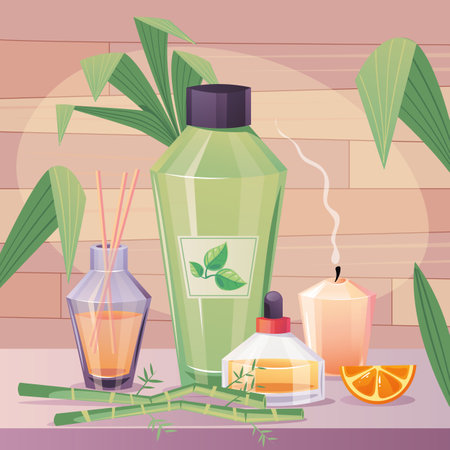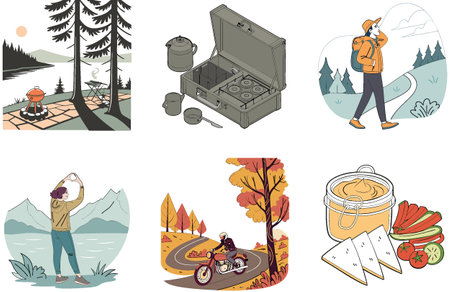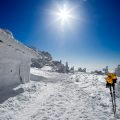Introduction: Staying Hydrated on the Trail
Summer hiking in America is a true adventure, offering everything from the soaring peaks of the Rockies to the rolling greens of the Appalachians. But with those stunning landscapes comes a serious challenge: staying hydrated under the hot sun and variable conditions. Whether you’re scrambling up granite ridges in Yosemite or wandering wildflower meadows in Shenandoah, dehydration can sneak up on you fast. In these diverse terrains—where elevation, humidity, and temperature can shift rapidly—having the right hydration gear isn’t just about comfort; it’s about safety and performance. This guide explores why hydration is so crucial during summertime hikes across the USA, setting the stage for our deep dive into the best packs and bottles to keep your adventures safe and satisfying.
2. Choosing the Right Hydration Pack
Summer hiking in America is as diverse as its landscapes, from the dusty switchbacks of Arizona’s Grand Canyon to the misty forests of the Pacific Northwest. Picking the right hydration pack means matching your gear not only to your personal style but also to the specific challenges of each trail. Below, you’ll find a visual guide to different hydration pack styles and how they fit the needs of American hikers—whether you’re chasing alpine sunrises or desert sunsets.
Hydration Pack Styles: A Quick Comparison
| Style | Best For | Capacity | American Hiking Context |
|---|---|---|---|
| Minimalist Vests | Trail runners, fast-packers, short hikes | 1–2 liters | Great for Appalachian Trail sections, day trips in Yosemite, or local park loops where speed and agility matter. |
| Standard Backpacks | Day hikers, moderate treks | 2–3 liters + extra storage | Perfect for summer day hikes in Rocky Mountain National Park or Shenandoah, with space for snacks and layers. |
| High-Volume Backpacks | Backpackers, multi-day trips, group leaders | 3+ liters + large cargo space | Ideal for long hauls in Glacier National Park or extended wilderness trips where water sources are spread out. |
Packing for Different Terrains and Climates
The vastness of America’s outdoors means your hydration strategy should flex with your adventure. In the arid Southwest, opt for higher-capacity reservoirs that keep you going when water stops are scarce. For humid East Coast trails, lightweight vests help you stay cool and nimble among dense woods. If you’re trekking through high-altitude Rockies or Sierra Nevada routes, look for packs with insulated sleeves to prevent water from overheating or freezing.
Fit and Comfort Matter Most
No matter your destination, a well-fitted hydration pack makes all the difference. Adjustable straps and breathable back panels ensure comfort during those long climbs up Utah’s red rocks or Oregon’s forested ridges. Try on several styles at your local REI or outdoor store—America’s best trails demand gear that moves with you every step of the way.

3. Top Hydration Packs for U.S. Hikers
When it comes to conquering classic American trails, choosing the right hydration pack is essential for comfort and performance under the summer sun. The best hydration packs available in the U.S. market are engineered with durability, ergonomic design, and smart features that keep hikers refreshed mile after mile.
Osprey Skarab & Skimmer Series
The Osprey Skarab (for men) and Skimmer (for women) are go-to choices among seasoned hikers on trails like the Appalachian or Pacific Crest. These packs offer a sturdy 2.5-liter reservoir, cushioned straps, and an AirScape back panel for cool airflow—crucial when temperatures soar in places like Zion or Yosemite.
CamelBak M.U.L.E.
CamelBak’s M.U.L.E. is a household name from the Rockies to the Smokies. Its 3-liter Crux reservoir delivers water quickly without leaking, while multiple pockets make stashing snacks, sunglasses, and maps easy. The ventilated harness keeps your back dry during those relentless Midwest climbs or desert hikes in Arizona.
Gregory Citro & Juno
For hikers who crave both comfort and organization, Gregory’s Citro (men’s) and Juno (women’s) lines blend ventilated VaporSpan backs with robust hydration sleeves and gear compartments. They’re built tough for rocky Colorado ascents or lush Pacific Northwest forests, with quick-drying mesh ideal for humid conditions.
Specialty Packs for Unique Terrains
If you’re tackling longer multi-day routes in national parks like Yellowstone or Grand Canyon, consider larger-volume options such as the Deuter Trail Pro series, which offers stable load distribution and extra space for layers and first-aid kits—important for sudden weather changes or extended days on trail.
Features Tailored to American Trails
The top-rated hydration packs often feature wide-mouth reservoirs for easy refills at U.S. park water stations, magnetic bite valves for one-handed sipping, reflective accents for safety on dusk hikes, and external attachment points perfect for trekking poles or bear spray—a must in grizzly country. When picking your summer hiking pack, prioritize fit and ventilation to stay cool and hydrated whether you’re chasing sunrise over Mount Rainier or traversing Utah’s red rock vistas.
4. Best Water Bottles for Hiking
When summer sun scorches the trails from Zion to the Smokies, your water bottle becomes your best friend. The choice between insulated and lightweight bottles isn’t just about taste—it’s about keeping cool, treading lightly, and caring for America’s wild places. Here’s how popular options stack up when you’re hiking famous U.S. trails:
| Bottle Type | Pros | Cons | Best For |
|---|---|---|---|
| Insulated Stainless Steel (e.g., Hydro Flask, YETI Rambler) | Keeps water cold for hours; durable; reusable | Heavier; bulkier; pricier | Hot, exposed hikes in Utah or Arizona where ice-cold refreshment lasts |
| Lightweight Plastic (e.g., Nalgene, CamelBak Chute Mag) | Featherweight; affordable; BPA-free options | Water warms quickly; less rugged | Long-distance treks like the Pacific Crest Trail, where every ounce counts |
| Collapsible Bottles (e.g., Platypus SoftBottle) | Packs down small; ultra-lightweight; eco-friendly materials | Can be harder to clean; may not keep water as cool | Backpacking in Yosemite or the White Mountains where space is premium |
Staying Cool and Eco-Friendly on American Trails
An insulated bottle shines on sunny switchbacks of Joshua Tree or when pausing at a Grand Canyon overlook—your last sip still frosty. For Appalachian rambles or Colorado peak-bagging, a lightweight plastic bottle feels almost invisible in your pack but won’t shield against midday heat. Collapsible bottles are perfect for multi-day journeys: fill up at a Sierra spring, then stow flat as you descend. Whichever you choose, opt for BPA-free and recyclable materials to protect those sweeping vistas and minimize your footprint.
Pro Tips from U.S. Hikers
- Add ice before you hit the trail—insulated bottles keep it solid for miles.
- Mark your bottle with a line for every half-liter—easy tracking helps prevent dehydration under the Texas sun.
- Refill at visitor centers or natural springs (where allowed) and skip single-use plastics—every hiker makes a difference.
5. Hydration Tips and Trail Etiquette
Expert Advice for Staying Safe and Hydrated on U.S. Trails
America’s summer trails are as varied as its landscapes—from the misty peaks of the Pacific Northwest to the sunbaked canyons of Utah. No matter where you hike, staying hydrated is non-negotiable. Experts recommend starting your hike well-hydrated: drink water before you hit the trailhead, and pack enough to sip regularly (about half a liter per hour in hot conditions). For longer treks or high-elevation climbs, consider electrolyte tablets or powders to replace minerals lost through sweat.
Leave-No-Trace Water Practices Unique to U.S. Parks
The United States’ national parks and wilderness areas have special guidelines to protect delicate ecosystems. Always pack out what you pack in—this includes empty hydration bottles and any disposable filter cartridges. Refill only at designated water sources or use portable filters when drawing from streams or lakes, ensuring you’re not contaminating these habitats. Never wash bottles or packs directly in natural waterways; instead, use biodegradable soap at least 200 feet away from any source.
Respecting Others and the Land
Trail etiquette goes hand-in-hand with hydration: yield to uphill hikers when stopping to take a sip, and keep bottle caps secure to avoid accidental littering. If you need to relieve yourself, follow local rules—often this means carrying out used wipes or packing a trowel for proper disposal away from water sources. By following these hydration tips and leave-no-trace principles, you’ll help keep America’s wild places pristine for generations of hikers to come.
6. Recommended Accessories for Summer Trekking
Staying hydrated in the American backcountry goes beyond just carrying water—it’s about being prepared, comfortable, and safe on every trail. Here are some essential hydration accessories that elevate your summer hiking experience from coast to coast.
Water Filters & Purifiers
American trails often weave through remote wilderness where clean water sources aren’t guaranteed. Lightweight water filters like Sawyer Squeeze or LifeStraw allow you to refill safely from lakes and streams—a must-have for multi-day treks in places like the Rockies or the Pacific Northwest. For group hikes, pump purifiers or gravity-fed systems make refilling at basecamp efficient and communal.
Reservoir Cleaners & Maintenance Kits
Hydration bladders can develop mold and unpleasant odors if not maintained properly—especially in hot, humid American summers. Cleaning kits with flexible brushes and special tablets ensure your gear stays fresh trip after trip. Brands like CamelBak and Platypus offer tailored cleaning solutions to keep your reservoir tasting mountain-crisp.
Cooling Towels & Bandanas
The American Southwest sun doesn’t play around. Cooling towels, made from moisture-wicking material, can be soaked in any stream and draped around your neck for instant relief on exposed ridgelines. Multifunctional bandanas pull double duty: wet them for a cool-down or use them as a dust mask during high-desert gusts.
Extra Bite Valves & Quick-Disconnect Kits
Nothing ruins a hike faster than a leaky valve or tangled hose. Pack an extra bite valve—most major brands have universal fits—and consider quick-disconnect kits for easy refilling at busy trailheads or national park campgrounds. These simple additions reflect the practical, “be prepared” spirit of American outdoor culture.
Pro Tip: Carabiners & Bottle Slings
Clip a carabiner to your bottle or pack for fast access—ideal for those classic summit photos with your favorite hydration gear in hand. Bottle slings also free up space inside your backpack, keeping essentials within reach as you cross alpine meadows or desert canyons.
With these accessories dialed in, you’ll be ready to tackle everything from Appalachian greenways to Sierra granite, all while keeping cool, safe, and hydrated under the summer sun.
7. Conclusion: Summertime Adventures Made Safer
Picture yourself winding through America’s most iconic trails—sunlight glinting off alpine lakes, wildflowers painting the meadows, and the vast blue sky arching overhead. As you step into these unforgettable summer landscapes, your hydration pack or bottle becomes more than just gear; it’s a trusted companion that lets you savor every mile safely. From the craggy Rockies to the lush Smokies, reliable hydration keeps your adventure rolling and your spirits high, even under the blazing American sun. So before your next trek, make sure you’re equipped with the best hydration packs and bottles—because staying refreshed isn’t just about comfort; it’s the key to making memories that last and coming home safe. Choose wisely, hike boldly, and let every trail reveal its wild beauty—one cool sip at a time.


